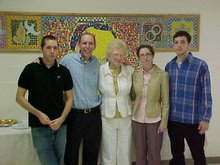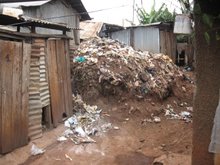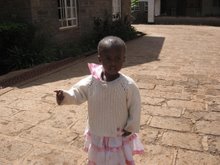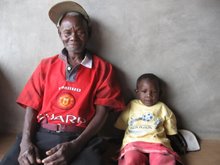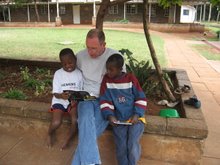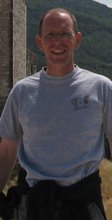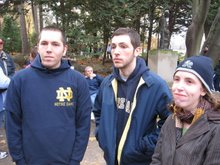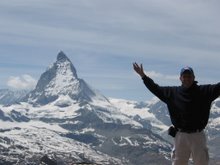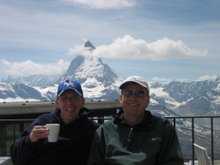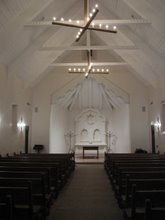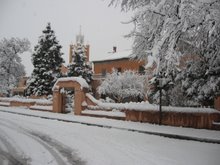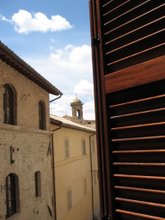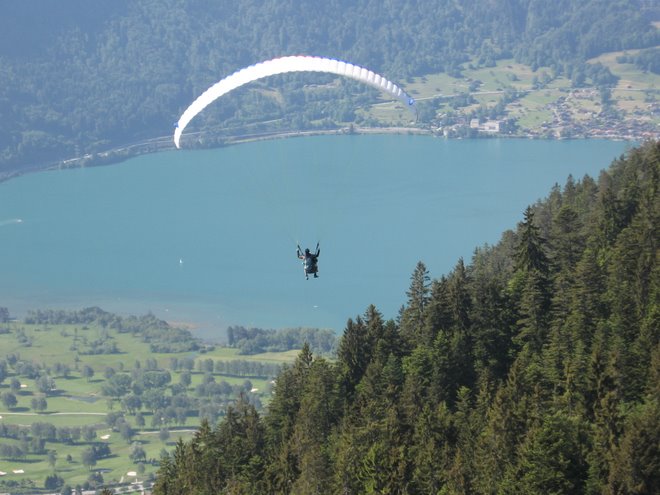From the shamba, we drove to the hospital to receive some treatment for Sr. Little. She has leukemia, and for now it is under control. She recently was sent back to India for further tests etc. She looks fine now, just tires sometimes and watches contracting other diseases due to her compromised immune system.
From the hospital we took a trip to
 Kibera, the largest slum in Africa, second largest in the world next to India, and home of over one million Kenyans. Nothing has changed since my last visit, although the arrangement of Lea Toto clinic and daycare has changed to make more room for the clinic, run by the program. (From a meeting recently at the Children's Home I was told that in the last two weeks, thirteen children have died in the Lea Toto program. Some died from measles, menengitus, or other related diseases to malnutrion. Sr. Little says that the children come into the program so weak and sick. It is difficult for them to recover.) We met some of the staff there and also a "new mama" who was seated outside the clinic waiting to be tested. Sr. asked to go to her house to visit and show Maria and I her living conditions. The woman looked very tired, as did her little boy on her back. She was covered with a skin problem, probably scabies from poor hygiene. She was waiting to be tested for HIV. If she or her child test positive, they will be entered into the program and receive ARVs (AIDS Meds) and the food necessary to allow the drugs to work.
Kibera, the largest slum in Africa, second largest in the world next to India, and home of over one million Kenyans. Nothing has changed since my last visit, although the arrangement of Lea Toto clinic and daycare has changed to make more room for the clinic, run by the program. (From a meeting recently at the Children's Home I was told that in the last two weeks, thirteen children have died in the Lea Toto program. Some died from measles, menengitus, or other related diseases to malnutrion. Sr. Little says that the children come into the program so weak and sick. It is difficult for them to recover.) We met some of the staff there and also a "new mama" who was seated outside the clinic waiting to be tested. Sr. asked to go to her house to visit and show Maria and I her living conditions. The woman looked very tired, as did her little boy on her back. She was covered with a skin problem, probably scabies from poor hygiene. She was waiting to be tested for HIV. If she or her child test positive, they will be entered into the program and receive ARVs (AIDS Meds) and the food necessary to allow the drugs to work.We walked with them into the slums and to her house. It had rained the night before, so everything had extra mud and the usual smell. Her "house" was typical, one small room divided by a sheet for sleeping. There was a small charcoal grill for whatever cooking was done. She said she was lucky. She had two children and her husband was with her. We also visited a neighbor, also in the Lea Toto program. She had 6 children, the youngest has turned negative but the mother remains positive (and will continue) and she showed us the life-saving drugs she was taking. Her 19 year old was also living there with her 16 month old baby. The woman had left her husband and showed us some of the embroidery work she was selling for extra money. We left the houses, returned to the clinic and the car to head out. On the way we were yelled at by an old man calling us "slum tourists". Sister Little was surprised at his yelling, usually the people respect the sisters and the habit.
 From Kibera we were dropped off at Kivuli Centre, another Vocational School of sorts. We met John, a new manager who was happy to give us a tour of the facility and show us the products and work being done. Kivuli Centre is the boarding home for 60 young boys who go elsewhere for school each day. It is in the heart of another slum, made up of a large number of Rwandan refugees who fled their homeland because of tribal fighting. They spoke mostly French. (Constantine pictured to the left. Great young man with talent and who spoke only French from Rwanda. These men worked at the Centre, lived in the slums and sold their products to a Fair Trade business. Their work was beautiful and the men were very willing to show us all their work and how it was done. There were products other than woodcarving - batiks, paper-making, as well as dressmaking and furniture making - among other crafts.
From Kibera we were dropped off at Kivuli Centre, another Vocational School of sorts. We met John, a new manager who was happy to give us a tour of the facility and show us the products and work being done. Kivuli Centre is the boarding home for 60 young boys who go elsewhere for school each day. It is in the heart of another slum, made up of a large number of Rwandan refugees who fled their homeland because of tribal fighting. They spoke mostly French. (Constantine pictured to the left. Great young man with talent and who spoke only French from Rwanda. These men worked at the Centre, lived in the slums and sold their products to a Fair Trade business. Their work was beautiful and the men were very willing to show us all their work and how it was done. There were products other than woodcarving - batiks, paper-making, as well as dressmaking and furniture making - among other crafts.There was a music group and dance troupe shooting a music video at the Centre and Maria and I were asked to be a part of it - so we danced with girls in revealing attire and shirtless young men. We made attempts at some African moves and can't wait to see the video which we were assured would be on TV soon. It was a fun experience.
Once our work was completed at the Kivuli Centre, we walked through the slums and searched for a bus or a Matatu to take us to a location in the city that was more familiar. We were quite the site - the only muzungus in the area. In fact, through my travels throughout the day, the only white people were to be found in the nice restaurants and in taxis. No whites on our bus or on our matatus. No whites walking the streets of Nairobi - not even one. What's up with that? Eventually we found a bus and traveled to Ngong Road, a street familiar to us and we regrouped and ate lunch.
From Ngong we took a bus downtown to try to locate the Ministry of Labor and a department which would help us gain information on Vocational Training Centers and the Curriculum for beginning such a school. We searched through a couple large buildings which houses Social Security type offices, met with some men who tried to be helpful but we finally decided we needed to head for the Ministry of Labour and Human Resource Development. This office was located somewhere in the Industrial Area and Commerce Road. It was "near the Stadium" - wherever that was. We walked and must have asked for directions ten different times. Finally after a long, long walk we found the building and met with Meshack Otiendo Kidenda, the Director of Industrial Training. He was somewhat helpful but directed us to another office, downtown "The Ministry of Youth Affairs." This is a relatively new ministry and the Vocational Centres are under their direction. After walking through a downtown slum and passing over the railroad tracks on a wooden bridge, (another long, long walk) we headed for KenCom, a government building in the heart of Nairobi. It was a difficult entry, having left our passports at home, I wrote down my drivers license as my official ID number as I singed in the government building. We met with Mwangi Kahenu, Deputy Director of Training. He has everything we need - syllabus, curriculum, other materials but they will not be available until January. This whole area of Vocational Education has been reworked and "improved" with help from the United Nations and a couple of other large entities. We hope to be able to offer classes at the Nyumbani Village in woodworking, dressmaking, Agro-Farming and production etc. But we need assistance in setting up the school and curriculum. This is Maria's task, to develop a plan to be evaluated and hopefully implemented at some time. All of our work was simply to gather information and we had much.
From the Ministry of Youth we headed for a bus or Matatu and home to Karen. We left the city at 5:30 - rush hour on a Friday in Nairobi - impossible. We were locked in traffic for over and hour. After reaching Karen, we made the long walk to the Children's Home - while it was getting dark. The volunteers were headed to a nearby British restaurant to say goodbye to one volunteer who was leaving - eventually heading home to the states.
It was a good day - but so long!

